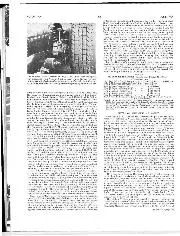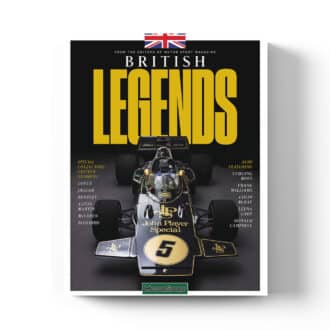

The XIV Gran Premio Napoli
A Ferrari Test Run Naples, Italy, April 12th. Wth races crowding on top of each other, Naples suffered from the lack of factory support from Maserati, just as Pau had…
OUTBOARD MOTOR BOATING.
A NEW AND FASCINATING SPORT FOR MOTORISTS.
By J. W. SHILLAN.
FOR years before the war motor boat racing attained a certain degree of popularity, but its appeal was of necessity very limited owing to the great expense involved. The war practically killed this sport, but now it has appeared again, although in an entirely new guise. A hereas, previously, it was restricted to the few who had unlimited money to spend, it is now open to the man of moderate means. This is due to the enormous development that has taken place during the past two or three years in the design of outboard motors and hulls.
Of course, outboard motors have been on the market for a good many years as the motive power for rowing boats, punts, etc., which was the purpose for which they were originally designed.
Until about three years ago, ten miles an hour was considered to be the maximum speed obtainable with an outboard driven boat. Research on the part of the engine manufacturers, however, resulted in the evolution of the high-speed outboard motor. With this engine better speeds were made, but it was soon found that the motor was superior in efficiency to the hull. It was then up to the boatbuilders to produce an article which could utilise the maximum efficiency of the motor. The result was an outfit capable of a speed very much greater than any that had been previously obtained, and from that point the development was very rapid, the design of motors and hulls progressing simultaneously ; with the result that there are now on the market outboard craft capable of speeds of thirty-five miles per hour, and even more. Whereas, in the old days, boats to give this performance would run into something like four figures, such a craft can now be purchased for little more than L’ioo.
Boats powered by smaller motors giving speeds of twenty-five miles an hour or so can be purchased for very much less than even this modest figure, and the result is that outboard motor boat racing is becoming exceedingly popular.
At present, all outboard races, held under the auspices of the B.M.B.C. and the I.M.Y.U., are scratch races. It is found that these give very much better sport— both from the competitors’ and spectators’ points of view. For racing purposes, outboard craft are divided into
four classes and races are held for each of these. Class ” A ” is for boats powered with engines of not more than 250 c.c. capacity. Class” B ” is for boats powered with engines having a capacity of 250 to 350 c.c., and Class ” C ” is for boats having an engine capacity of 350 to 500 c.c., while Class ” D ” is for boats powered with engines of unlimited capacity.
At present, hulls are unrestricted in all classes and any design may be used.
Race meetings Are now organised in most of the boating centres in the country. In London, they are held on the ” Welsh Harp,” Hendon, once a month during the season. Meetings at the ” Welsh Harp ” always attract very large fields and provide most exciting sport. The thrill of driving a bouncing hydroplane or skimmer at 30 miles an hour is far greater than that of blinding along the road at sixty, and, of course, scorching on the water is very much safer than on the road both for the participants and the onlookers. The worst trouble that can befall a competitor or in an outboard motor boat race is an involuntary dive due to his overturning his craft by attempting to take a corner a little too finely in an effort to overhaul a rival.
With regard to the conduct of the actual racing, the start is always a flying one. Five minutes before the race a gun is fired upon which the competing boats run round behind the starting line, and the idea is to open out and make a dash for the line so that it is crossed
immediately after the starting gun is fired. To see a dor.en or more boats dash over the line in a cloud of spray is a wonderful sight, and it is easy to appreciate that these meetings are attracting a rapidly increasing number of spectators.
The types of hulls used are hydroplanes or skimmers of from eight to 14 feet in length. When such boats are driven by powerful motors they plane along the surface and draw no water at all, thus offering a very slight resistance and allowing high speeds to be attained. Many weird and wonderful designs of hull have been experimented with, but designs are now becoming more standardised.
The motors are self-contained units which can be instantly attached to the boat by screwing up A pair of thumb-screWs. They are, almost without exception, of the two-stroke type, and until recently have been either single cylinder or twin cylinder jobs. The motor illustrated herewith, however, marks a new departure in outboard design. The “Free for All” Race at the meeting at Hendon on the 12th May was won easily by a boat powered with a motor of this type. This is the Super Elto ” Quad,” which is marketed by the Elto Motor Sales Company, 24, Harrison Street, Grays Inn Road, W.C.I. It will be seen that the arrangement consists of one pair of cylinders superimposed on another pair. Each pair of cylinders fires simultaneously, ignition being on the uni-sparker system served by dry battery and coil. This enables starting to be accomplished by a simple flip of the flywheel and prevents ignition trouble due to spray getting on to the motor. The makers will be very pleased to send full details of this motor to those interested, and to give an actual demonstration at the “Welsh Harp.”
The design of the modern outboard is not greatly different from that of the two stroke motor cycle engine.
The crank shaft is vertical and is coupled to a vertical drive shaft, having a bevel gear at its lower end. The drive is taken by a short horizontal shaft to which the propellor is secured.
Water circulation on most outboard motors is by means of a small plunger pump, but, in the case of the model illustrated, all troubles due to the sticking-up of the valves and so on have been eliminated by the introduction of the propellor pump system. In this system there are no moving parts, the water being driven through passages into the cylinder jacPets by the force of the propellor, in the same manner as a train scoops water off the track.
One of the great advantages of the outboard craft is the fact that it can be transported with the greatest ease on a trailer behind a car. The motor itsElf is easily portable, and can be carried on the running board or luggage carrier. Many outboard racing enthusiasts transport their outfits in this manner, and attend race meetings in various parts of the country.
Of course, outboard motor boating is by no means confined to racing. A four-seater hull suitable for family cruising purposes can be transported in the same manner as a racing boat, and will be the source of endless enjoyment to the owner and his friends. A quiet voyage on river and sea makes a very welcome change from the dust and congestion of the roads.



